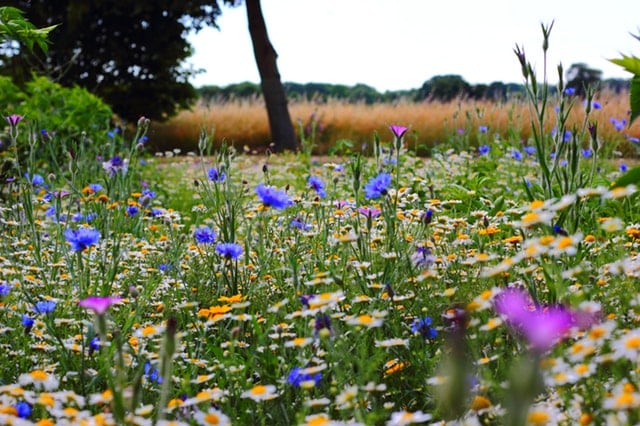
30 Aug GROW YOUR OWN MEADOW
Thoughts of wildflower meadows evoke strong childhood memories for me. They take me back to growing up in the North Downs with its chalky landscape of scabious and cowslips. These happy memories alone would be enough to make me want to recreate my own version at home. After seeing the display at the Olympic Park in 2012 I can understand their popularity amongst garden designers and gardeners. After all, wildflowers seem to offer the winning combination of a low maintenance, ecologically responsible, and pretty option for any size of open space.
But is a meadow really as easy to create and maintain as it appears?
Well perhaps, but it certainly helps to have a basic understanding of what wildflowers do and what they need. True meadows are grasslands that support perennial (not annual) flower species which have evolved to flower and produce seed in time for the farmer’s annual cut for hay production. Traditionally, farmers leave the clippings to dry alongside the grass, allowing the seeds to shake out and re-set.
In today’s ‘garden’ meadows there is a place for the colourful interest of annual species such as poppies and cornflowers. However, a yearly task of digging the soil over and re-seeding is needed to continue the display.
The main issue to grasp is that meadow flower species need soils with poor fertility. Where soil fertility is good grass will always dominate. At the end of the summer, meadows are cut down to the ground with a strimmer or ideally a scythe, left for up to a fortnight to allow the drying seeds to fall out. The key is to carefully and faithfully remove clippings after this annual cut to prevent enriching the soil further.
If your soil is light and poor you have the best start to create your own mini meadow from seed. Richer soil should have the topsoil removed first. After removing all weeds and raking over to create a seedbed, scatter specially prepared wildflower seed mixes suitable for your soil type. Never add fertiliser! You can achieve the effect faster by laying pre-grown wildflower turf, bought in rolls, although you pay for the convenience.
Wildflower turf in use
This autumn Holland Landscapes will embark on the second phase of construction of a large country garden near Ongar in Essex. Its steeply sloping contours have been transformed by terraced levels of lawn linked by banks of wildflower meadow. For an (almost) instant effect Meadowmat, a roll of pre-grown wildflower turf was laid. This was a speedier and more reliable method than than sowing seed on existing lawn.
These meadow sections have given the garden context in its rural setting, blending the highly designed garden near the house into the surrounding fields and hedgerows.
So why not try growing your own meadow? You’ll be cultivating the latest look, and the bees and butterflies will love you for it.
Take a look at the case study for our wildflower meadow project in Ongar
Looking for low maintenance garden ideas? Read our article here



Sorry, the comment form is closed at this time.